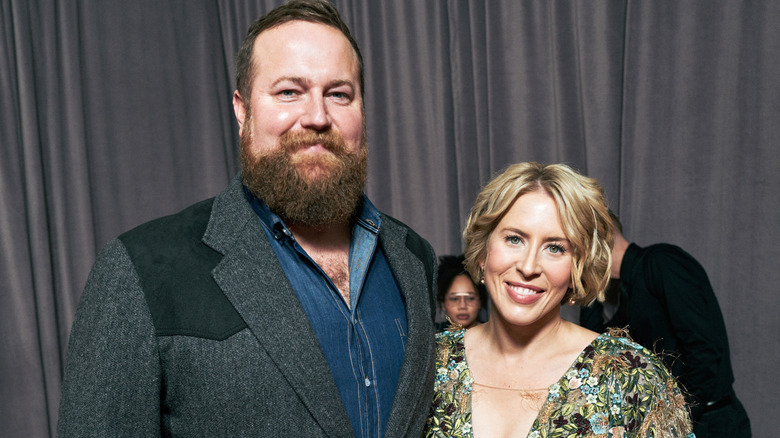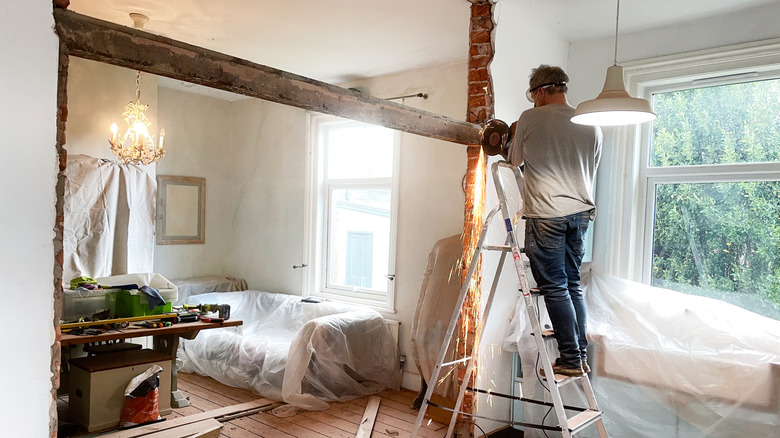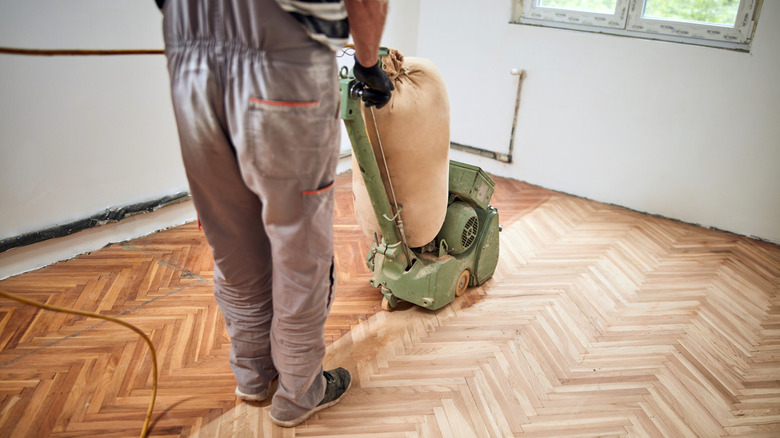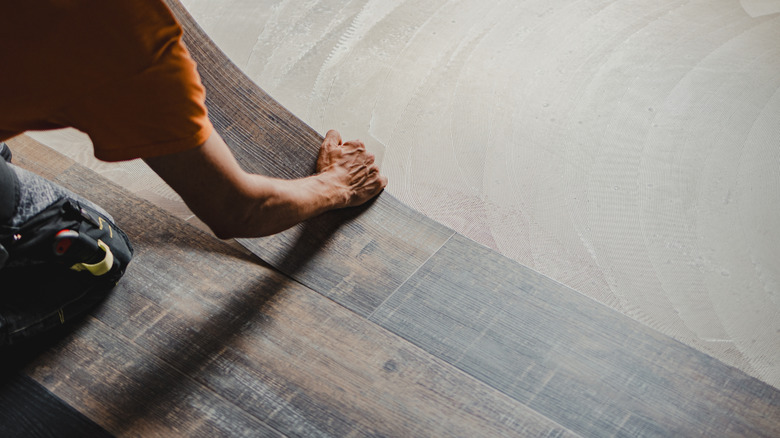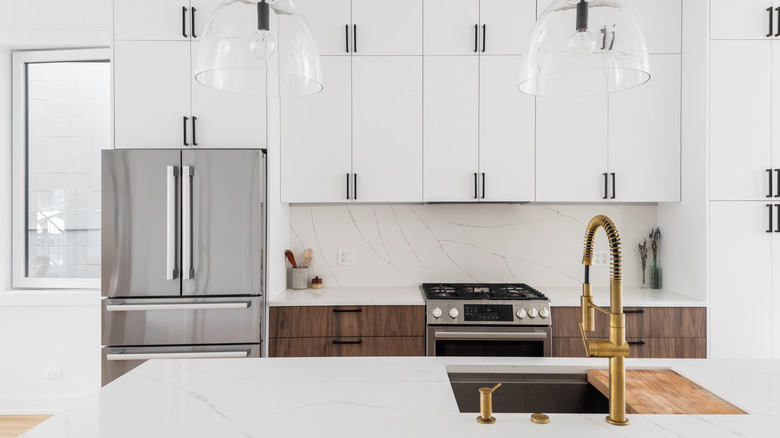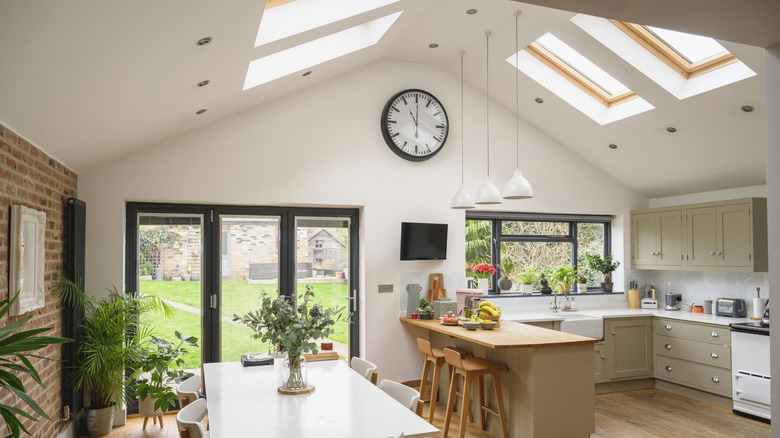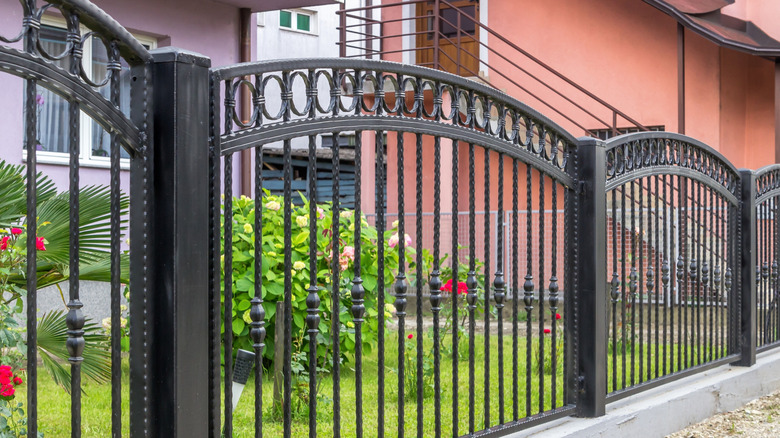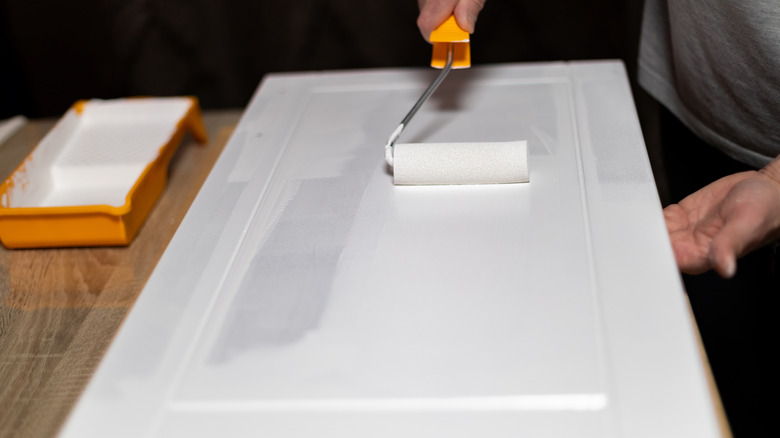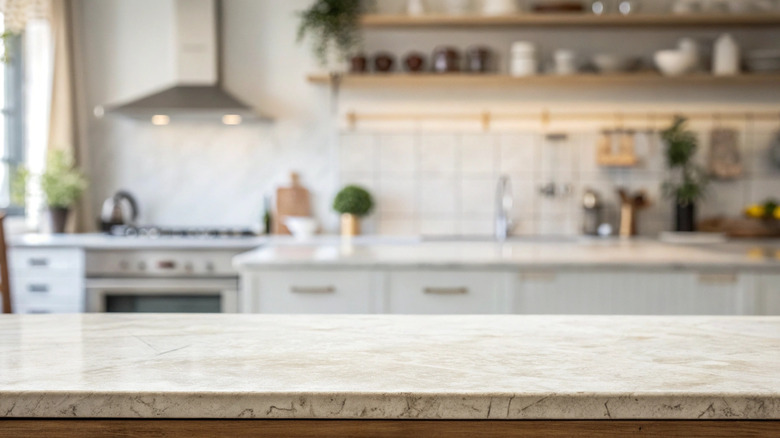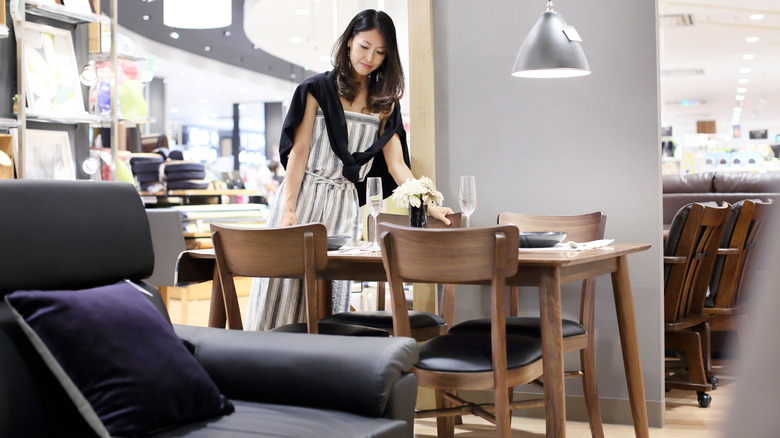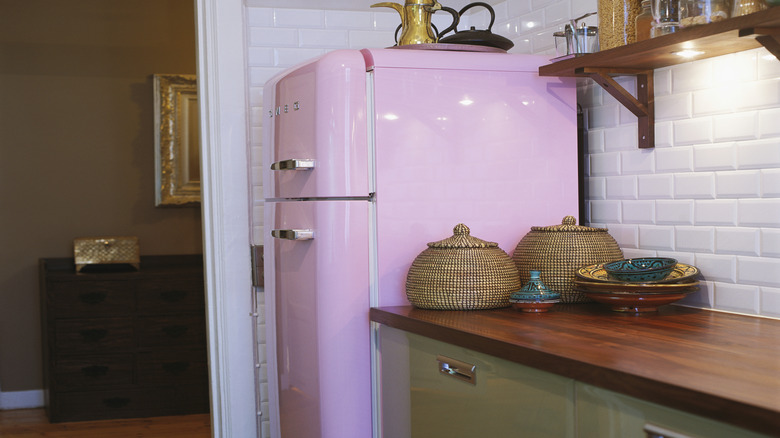Home Upgrades That Are A Waste Of Money, According To HGTV's Erin Napier
Erin Napier has shown that she loves a good vintage rug and a gallery wall of antique plates, y'all. But curating a perfectly styled home and scoring a sweet deal are also favorites of the designer. Even before she and husband Ben Napier were churning out charmers on their long-running HGTV series "Home Town," the Mississippi-based couple were creating magic with their own 1925 home. They transformed the kitchen on a budget, crafting new doors for their existing particle board cabinets and hanging inexpensive subway tile and pendant lighting.
Though the parents of two have since swapped out the secondhand appliances from Craigslist and the cast-iron sink they scored for free at a flea market, their make-do mindset remains. Erin doesn't shy away from repurposing kitchen paneling as a backsplash or opting for vinyl flooring over pricey tile. And she and Ben would be the first to tell you there are few things a $30 gallon of paint can't fix. So, take some cues from the duo and focus on thoughtful, budget-friendly upgrades while avoiding ones that are a waste of your reno funds.
Knocking down walls costs money and removes character
Yes, contractors love to swing a sledgehammer, but sometimes demo day isn't the answer. And though it seems that everyone loves an open floor plan, well, Erin isn't everyone. So when she saw the plethora of walls in the 1940s build that they renovated in "Home Town" Season 5, Episode 5, she wasn't tempted to let them crumble. "I like rooms, and I like little nooks," she explained of leaving all the walls intact. "That's what makes a house interesting."
It's also what makes a remodel stay under budget. The average price to remove a wall can range from $300 to $1,000. And that bill jumps up to between $1,200 and $10,000 for a load-bearing one. Of course, that's just one of the things you should know before you knock down a wall. You also need to investigate if there are any plumbing or electrical lines that you'll have to pay to remove, and figure out what sort of permit you would need to obtain.
Replacing older floors strips away the charm
New doesn't necessarily mean improved, as Erin demonstrated in the same season 5 episode. Stripping away the home's bright orange carpet, they uncovered the original hardwood and were, quite frankly, floored. Though the boards weren't exactly uniform with patches of lighter and darker wood, the imperfections only elevated the house's charm. "This is what I love about hardwood floors," Erin raved of the final result. "They really tell the history of the house."
If you're in a position to keep the OG floor coverings, part of that story will be how much money you saved, as replacing them is a huge expense. Installing hardwood can cost up to $6 per square foot. This means covering every inch of a 2,000-square-foot home would set you back $12,000. And there are plenty of ways to bring old hardwood floors back to life, including using a wood rejuvenating product to fill in cracks and scratches, renting a commercial-grade buffer to tackle deeper nicks, and removing stains with wood bleach.
If you do replace floors, though, skip the expensive tile
Vinyl flooring doesn't have the best reputation. But Erin and her husband seem to think that you'll be on solid ground if you opt for the product that's made using several layers of synthetic material, the most prominent being polyvinyl chloride. Not only affordable, it's also durable and can be quite eye-catching if you select the right brand. Using a luxury vinyl tiling for one renovation, Ben marveled at how the pieces easily locked into place. "It wears great," Ben told Today, noting that if used in areas prone to flooding, it can be pulled up, dried out, and put back in place. "It has a really long life span, it's cheap, kidproof, waterproof, petproof, etc."
There are some common types of vinyl flooring, which rings in at roughly $2 to $6 per square foot. Opt for large panel sheet vinyl, vinyl composite tile, or luxury vinyl planks or tile, meant to mimic a high-end look. Resistant to scratching, scuffing, and water, they just require regular sweeping and mopping with a mild cleaner.
Ripping out all your fixtures to match metals is costly and unnecessary
It can feel as if the gold standard in home decor is to have your drawer pulls match your cabinet hardware and your faucet. But Erin swears it's actually far more attractive if they're not perfectly coordinated. "In our kitchen, I've got brushed brass, unlacquered brass, stainless steel, copper, and oil-rubbed bronze," she detailed on her site. "All the metals work together to keep it feeling warm and not so boring and matched."
In other words, no need to spend a ton ripping out all your fixtures and replacing them with an identical set. The key to mixing metals in your home decor is to select one dominant metal. Since chrome finishes tend to be the same across brands, it's a solid pick. Then, sprinkle in other metallic accents. To keep everything cohesive, opt for the same finishes (matte, hammered, satin, brushed, powder-coated) throughout your space.
Skylights can be a pain to maintain
Sure, you want to lighten things up if your space is on the darker side. But Erin believes that the popularity of skylights has declined significantly. "We never see a skylight on a house anymore," she noted on Season 8, Episode 1 of "Home Town". Her take is that "people stopped doing it because they get very leaky." And that's just one downside to their maintenance. In addition to shelling out anywhere from $1,000 to over $2,800 to install, depending on size, brand, and material type, you'll have to climb up onto the roof (or pay someone) to clean them.
For those who want to let the sunshine in, a sun tunnel is a cost-effective skylight alternative. The highly reflective aluminum tubing is cheaper and quicker to install than a skylight. Plus, the material is also flexible enough to maneuver around obstructions like ceiling beams or air conditioning units.
Wrought iron is pricey and doesn't work in every home
Wrought iron certainly has a distinctive look. The highly-refined, low-carbon iron alloy often elevates a home's curb appeal by adding a dramatic flair. But Erin wouldn't advise, uh, striking while the iron is hot. Though wrought iron can class up certain spaces, it's a vibe that doesn't suit every style of home. As Erin noted in Season 5, Episode 7 of "Home Town," it can sometimes be a poor fit. "I just hate the overly ornate wrought iron on a house that is specifically all about straight lines," she explained.
Wrought iron generally mixes well with Victorian or Mediterranean-style houses, but adds a wrinkle to those with more minimalist designs. In this particular reno, Erin opted for a slatted wood wall. And while the installation for wrought iron and other metals can range up to $80 per foot, wood fencing clocks in at $10 to $30 a foot.
You don't need all new cabinets to give the kitchen a refresh
Installing a brand-new set of custom cabinets can be incredibly costly, stacking up to more than $6,000 on average. But when it comes to giving the kitchen a facelift, a more budget-friendly solution comes in a can. "It's amazing what you can pull off with paint," Ben explained to Business Insider about using a coat or two to give existing cabinetry a refresh. "A lot of times the cabinets are fine, and they just need to be painted," he explained.
To paint kitchen cabinets in just one day, consider investing in a tool like a Brushless Cordless Paint Sprayer. And make sure not to skip the all-important prep. You'll want to thoroughly clean each piece to remove grease and other residue, sand down the wood, fill in any chips, and cover the surface with a quality primer, which can cut down on the number of coats necessary.
Shelling out thousands of dollars for granite isn't necessary
Ask any prospective home buyer for their wish list, and there's a good chance granite countertops will fall somewhere near the top. But prices range from about $2,000 to $4,000 depending on the type of granite and the size of the countertops. "People shouldn't feel like they have to blow a fortune," Ben insisted to Business Insider. "The most expensive option isn't necessarily the best choice. You don't have to have marble." And he was ready to serve up a slew of more budget-friendly picks "that give the house a fresh look while also not breaking the budget."
While he name-checked "good laminate" and "more affordable stone options," a go-to for him and Erin is butcher block. Once seen as outdated, butcher block is a wooden countertop style that's trending again and starts at roughly $1,200. Still, you have to be willing to commit to regular treatments with cutting board oil to keep them looking smooth and shiny, wiping up spills immediately after they happen, and keeping trivets handy for any hot dishes.
Wood beams are beautiful but far more costly than lighter planks
No need to knock on you-know-what to cut costs for one trendy farmhouse style. Among Erin's savvy solutions when dealing with a tight budget is to forgo solid wood beams for planks of wood. As she explained in Season 8, Episode 4 of "Home Town," "When you want to have some natural wood in a doorway and solid beams are not in your budget, cypress planks are your friend." Though they offer a near-identical look, she noted, "The planks cost half as much as solid posts and beams, and it weighs a quarter as much."
Another option is to try this simple way to DIY faux ceiling beams. Anyone with a set of wood glue, nails, and a bit of know-how, plus three planks (you'll want a 1-by-6 board for the center and two 1-by-4 planks for the sides) can add character to their space. As an added bonus, they draw eyes up, making smaller rooms appear more spacious.
New furniture doesn't sport the same craftsmanship of antiques and vintage pieces
Trolling thrift shops for furniture pieces is certainly economical. But that's not the only reason Erin recommends going second-hand when dressing up your space. "Here's the deal — if you can buy antique instead of new, you should," she said in Season 8 Episode 6 of "Home Town." Beyond the opportunity for smart shoppers to score some solid deals, "Things like dinner tables, little side tables, books," she noted, "the design and craftsmanship of those pieces are usually exceptionally good without any of the funky smells that you usually find in vintage upholstery."
To successfully buy antique furniture for your home, arrive armed with your space's dimensions and, ideally, a photo of the area the piece will go. For the best quality, scour antique shops, second-hand stores, flea markets, and estate sales. Look for pieces made with solid wood and consider how easily you'll be able to repair surface flaws like chips or scratches.
Before springing for custom appliances, consider this cheap fix
A vintage-inspired SMEG fridge is adorable, but the $5,000-plus price tag may leave some homeowners out in the cold. So, on the Season 9 finale of "Home Town", Erin used a budget-friendly hack that instantly customized the kitchen, using a light green vinyl wrap to cover the existing fridge. The solution works much like peel-and-stick wallpaper. "The vinyl wrapped appliances are my favorite idea I've ever had," Erin acknowledged on Instagram. "I love the way Rose is unafraid of color and living out loud, and I wish it for us all."
There are tons of options out there to show your true colors — or even a floral, patterned, or nature-inspired design. Once you've cleaned and dried the surface and tested that the wrap will stick, simply apply and smooth out. Just keep a utility knife handy in case you need to trim any excess.
